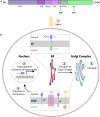CREB3 Transcription Factors: ER-Golgi Stress Transducers as Hubs for Cellular Homeostasis
- PMID: 31334233
- PMCID: PMC6616197
- DOI: 10.3389/fcell.2019.00123
CREB3 Transcription Factors: ER-Golgi Stress Transducers as Hubs for Cellular Homeostasis
Abstract
CREB3 family of transcription factors are ER localized proteins that belong to the bZIP family. They are transported from the ER to the Golgi, cleaved by S1P and S2P proteases and the released N-terminal domains act as transcription factors. CREB3 family members regulate the expression of a large variety of genes and according to their tissue-specific expression profiles they play, among others, roles in acute phase response, lipid metabolism, development, survival, differentiation, organelle autoregulation, and protein secretion. They have been implicated in the ER and Golgi stress responses as regulators of the cell secretory capacity and cell specific cargos. In this review we provide an overview of the diverse functions of each member of the family (CREB3, CREB3L1, CREB3L2, CREB3L3, CREB3L4) with special focus on their role in the central nervous system.
Keywords: CREB3 transcription factors; ER stress response; Golgi stress response; cellular homeostasis; central nervous system; secretory capacity; secretory pathway.
Figures



Similar articles
-
CREB3L2 Modulates Nerve Growth Factor-Induced Cell Differentiation.Front Mol Neurosci. 2021 Aug 3;14:650338. doi: 10.3389/fnmol.2021.650338. eCollection 2021. Front Mol Neurosci. 2021. PMID: 34421533 Free PMC article.
-
An orchestrated program regulating secretory pathway genes and cargos by the transmembrane transcription factor CREB-H.Traffic. 2013 Apr;14(4):382-98. doi: 10.1111/tra.12038. Epub 2013 Jan 24. Traffic. 2013. PMID: 23279168 Free PMC article.
-
Transcriptional regulation of secretory capacity by bZip transcription factors.Front Biol (Beijing). 2015 Feb 1;10(1):28-51. doi: 10.1007/s11515-014-1338-7. Front Biol (Beijing). 2015. PMID: 25821458 Free PMC article.
-
Regulatory mechanisms of the cAMP-responsive element binding protein 3 (CREB3) family in cancers.Biomed Pharmacother. 2023 Oct;166:115335. doi: 10.1016/j.biopha.2023.115335. Epub 2023 Aug 16. Biomed Pharmacother. 2023. PMID: 37595431 Review.
-
The Role of Mammalian Creb3-Like Transcription Factors in Response to Nutrients.Front Genet. 2019 Jun 21;10:591. doi: 10.3389/fgene.2019.00591. eCollection 2019. Front Genet. 2019. PMID: 31293620 Free PMC article. Review.
Cited by
-
Differentially Expressed Genes Regulating Glutathione Metabolism, Protein-Folding, and Unfolded Protein Response in Pancreatic β-Cells in Type 2 Diabetes Mellitus.Int J Mol Sci. 2023 Jul 27;24(15):12059. doi: 10.3390/ijms241512059. Int J Mol Sci. 2023. PMID: 37569434 Free PMC article.
-
Transcription factor Creb3l1 regulates the synthesis of prohormone convertase enzyme PC1/3 in endocrine cells.J Neuroendocrinol. 2020 Apr;32(4):e12851. doi: 10.1111/jne.12851. Epub 2020 Apr 21. J Neuroendocrinol. 2020. PMID: 32319174 Free PMC article.
-
CREB3L2 Modulates Nerve Growth Factor-Induced Cell Differentiation.Front Mol Neurosci. 2021 Aug 3;14:650338. doi: 10.3389/fnmol.2021.650338. eCollection 2021. Front Mol Neurosci. 2021. PMID: 34421533 Free PMC article.
-
From Phenomenon to Essence: A Newly Involved lncRNA Kcnq1ot1 Protective Mechanism of Bone Marrow Mesenchymal Stromal Cells in Liver Cirrhosis.Adv Sci (Weinh). 2023 Jul;10(21):e2206758. doi: 10.1002/advs.202206758. Epub 2023 Jun 6. Adv Sci (Weinh). 2023. PMID: 37282819 Free PMC article.
-
Creb3l3 deficiency promotes intestinal lipid accumulation and alters ApoB-containing lipoprotein kinetics.J Lipid Res. 2025 Jul;66(7):100833. doi: 10.1016/j.jlr.2025.100833. Epub 2025 May 29. J Lipid Res. 2025. PMID: 40449732 Free PMC article.
References
-
- Bailey D., O’hare P. (2007). Transmembrane bZIP transcription factors in ER stress signaling and the unfolded protein response. Antioxid. Redox Signal. 9 2305–2321. - PubMed
Publication types
LinkOut - more resources
Full Text Sources

